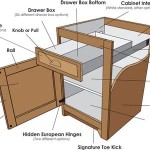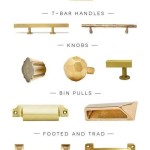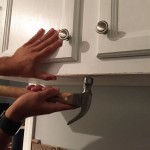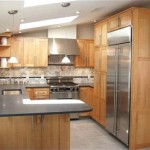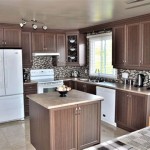How Much Does It Cost To Install New Kitchen Cabinets?
The kitchen often serves as the central hub of a home, and kitchen cabinets play a critical role in both the functionality and aesthetic appeal of this space. Installing new kitchen cabinets is a significant home improvement project that can drastically transform the look and feel of a kitchen while simultaneously increasing property value. A crucial element in planning such a project is understanding the associated costs. The total expense can vary widely, influenced by numerous factors, making it essential to carefully consider the specifics of the project before embarking on the installation.
Determining the cost of new kitchen cabinets involves a multifaceted assessment, taking into account the type of cabinets, materials used, labor costs, and any additional modifications required to the existing kitchen layout. A thorough understanding of these cost components will allow homeowners to create a realistic budget and make informed decisions regarding their cabinet selection and installation process.
Factors Influencing the Cost of Kitchen Cabinet Installation
Several key factors interact to determine the overall cost of installing new kitchen cabinets. These factors include the type of cabinets chosen, the materials from which they are constructed, the complexity of the installation, and the geographical location of the project.
Cabinet Type: The type of cabinet selected significantly impacts the final cost. Three primary types of kitchen cabinets are commonly available: stock, semi-custom, and custom cabinets. Stock cabinets are pre-fabricated and readily available at most home improvement stores. They offer the most economical option, but selection is limited in terms of styles, sizes, and finishes. Semi-custom cabinets provide a greater degree of flexibility, allowing for some modifications to the dimensions and features of stock cabinets. This option offers a balance between affordability and customization. Custom cabinets represent the most expensive option, as they are built to specific dimensions and design preferences. They offer the greatest degree of personalization but require a longer lead time for fabrication and installation.
Material: The materials used in cabinet construction also play a crucial role in determining the overall cost. Common cabinet materials include wood, plywood, particleboard, MDF (Medium-Density Fiberboard), and various laminate and veneer options. Solid wood cabinets are generally the most expensive, prized for their durability, natural beauty, and ability to be refinished. Plywood offers a strong and stable alternative to solid wood, often used for cabinet boxes. Particleboard and MDF are more affordable options, commonly used for cabinet doors and frames, but they are less resistant to moisture and damage than solid wood or plywood. Laminate and veneer finishes can be applied to any of these materials to achieve a desired aesthetic, with laminate being the more budget-friendly choice.
Installation Complexity: The complexity of the installation process can influence labor costs. A straightforward cabinet replacement involving similarly sized and configured cabinets will typically be less expensive than a complete kitchen renovation requiring significant modifications to the existing layout, such as moving plumbing or electrical lines. Older homes may also present unique challenges, such as uneven floors or walls, which can increase installation time and costs.
Geographical Location: Labor rates for cabinet installation vary significantly depending on geographical location. Metropolitan areas with a higher cost of living tend to have higher labor rates than rural areas. The availability of skilled installers and the demand for home improvement services in a particular area also contribute to price fluctuations.
Breaking Down the Cost Components
To gain a more comprehensive understanding of the cost involved in installing new kitchen cabinets, it's important to examine the specific components that contribute to the total expense. These components include the cost of the cabinets themselves, the cost of installation labor, and any additional expenses associated with permits, demolition, and disposal of existing cabinets.
Cabinet Costs: As previously mentioned, the cost of the cabinets themselves is a significant factor. Stock cabinets typically range from $70 to $200 per linear foot. Semi-custom cabinets generally cost between $150 and $500 per linear foot, while custom cabinets can range from $500 to $1,200 or more per linear foot. These prices represent a general estimate and can vary based on the specific brand, style, and materials used.
To calculate the approximate cost of cabinets for a kitchen, measure the total length of the wall space where cabinets will be installed. Then, multiply this measurement by the price per linear foot for the chosen cabinet type. For example, a kitchen with 20 linear feet of cabinet space using stock cabinets at $100 per linear foot would cost approximately $2,000 for the cabinets alone. A kitchen of the same size using semi-custom cabinets at $300 per linear foot would cost approximately $6,000.
Installation Labor Costs: Labor costs for cabinet installation typically range from $50 to $150 per linear foot. The actual cost will depend on the complexity of the installation, the experience of the installer, and the geographical location. Installing stock cabinets is generally less labor-intensive than installing custom cabinets, as stock cabinets require less modification and fitting.
To estimate labor costs, multiply the total linear footage of cabinet space by the installer's hourly rate. For instance, using the example of a 20-linear-foot kitchen and an installer's rate of $100 per linear foot, the estimated labor cost would be $2,000. This is a general estimate, and it's crucial to obtain quotes from multiple installers to compare pricing and experience.
Additional Costs: In addition to the cost of cabinets and installation, several other expenses may be incurred. Permits may be required for kitchen renovations, especially if the project involves structural changes or modifications to plumbing or electrical systems. Permit fees can vary depending on local regulations.
If existing cabinets need to be removed, demolition and disposal costs may apply. The cost of demolition can range from $500 to $1,000, depending on the size of the kitchen and the complexity of the removal. Disposal fees for old cabinets can also vary, depending on local landfill regulations.
Furthermore, homeowners may incur additional costs for miscellaneous items such as hardware (knobs, pulls, hinges), trim, and paint. These costs can range from a few hundred dollars to several thousand dollars, depending on the quality and quantity of materials chosen.
Tips for Managing Kitchen Cabinet Installation Costs
While installing new kitchen cabinets can be a significant investment, several strategies can help homeowners manage costs and stay within budget. These strategies include careful planning, choosing the right cabinet type and materials, obtaining multiple quotes, and considering DIY options for certain aspects of the project.
Plan Thoroughly: Careful planning is essential for controlling costs. Define a clear budget, determine the desired style and functionality of the new kitchen, and research different cabinet options. Consider the layout of the kitchen and how the new cabinets will integrate with existing appliances and fixtures. A detailed plan will help avoid costly surprises and ensure that the project stays on track.
Choose the Right Cabinets and Materials: Selecting the appropriate cabinet type and materials is crucial for balancing cost and quality. Stock cabinets offer the most economical option, while semi-custom cabinets provide a good balance between affordability and customization. Custom cabinets offer the greatest flexibility but are the most expensive. Consider the long-term durability and maintenance requirements of different materials. While solid wood cabinets are aesthetically pleasing and durable, they require more maintenance than laminate or veneer options.
Obtain Multiple Quotes: It's essential to obtain quotes from multiple contractors or installers before making a decision. Compare pricing, experience, and references. Ask for a detailed breakdown of the costs, including labor, materials, and any additional fees. Be wary of quotes that seem significantly lower than others, as this could indicate substandard workmanship or hidden costs.
Consider DIY Options: Depending on skill level and comfort level, homeowners may be able to handle certain aspects of the installation process themselves. For example, removing existing cabinets, painting, or installing hardware can be done as DIY projects to save on labor costs. However, it's important to assess one's abilities realistically and avoid attempting tasks that are beyond one's skill level, as this could result in costly mistakes.
Explore Financing Options: For homeowners who need assistance with financing the project, several options are available. Personal loans, home equity loans, and credit cards can be used to finance kitchen cabinet installation. Carefully compare interest rates and repayment terms before choosing a financing option.
Consider Refacing Instead of Replacing: If the existing cabinet boxes are in good condition, consider refacing instead of replacing the entire cabinet system. Refacing involves replacing the cabinet doors, drawer fronts, and hardware while leaving the existing cabinet boxes in place. This can be a more cost-effective option than replacing the entire cabinet system, especially if the layout of the kitchen is functional and the existing cabinets are structurally sound.
By carefully considering these factors and implementing these cost-saving strategies, homeowners can effectively manage the cost of installing new kitchen cabinets and create a beautiful and functional kitchen space without exceeding their budget. Obtaining detailed quotes, researching materials, and carefully planning the project are essential steps in ensuring a successful and cost-effective kitchen cabinet installation.

How Much Does It Cost To Install Kitchen Cabinets Az Cabinet Company

Average Cost To Replace Cabinets Forbes Home

Kitchen Installation Cost 2024 Data Angi

How Much Does It Cost To Install A Kitchen Victoriaplum Com

How Much Does A New Kitchen Cost In 2024 Checkatrade

The Cost Of Kitchen Cabinets For Your New

How Much Does It Cost To Install New Kitchen Cabinets

What Is The Average Kitchen Cabinet Cost

How Much Does A Kitchen Remodel Cost Forbes Home

Kitchen Cabinets Costs 2024 Data Angi

